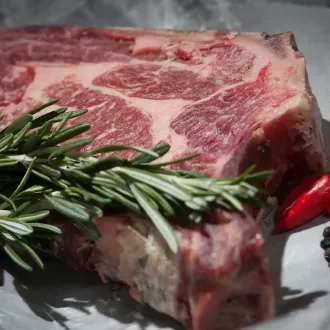Transcription Meat in carnivore nutrition
This lesson will focus on the main food of the carnivorous diet: meat. We invite you to discover the different types of meat, their properties and the precautions you should consider when consuming them.
The meat we consume is mainly the muscular tissue of certain animals. It is important to emphasize that the term meat, in food terms, is more a commercial classification than a biological one, since it does not include marine animals or human meat. For example, in supermarkets, the meat products section includes mammal, poultry and reptile meats, while fish and seafood are in a different section.
The meat industry generates the most revenue in the food sector. Despite being a controversial product and the growing trend towards veganism, meat consumption continues to increase globally. Market studies indicate that population growth could lead to the need to find solutions to meet the demand for meat in the future.
Types of meat
In this lesson, we will look at meat from a commercial perspective to help you decide which products to include in your carnivorous diet. Worldwide, there are two broad categories of meat: red meat and white meat.
Red meat: This classification refers to meats that have a reddish color in their raw state, such as mammals like beef, wild boar, bull, deer, and certain birds like partridges, quail and ostrich. Although most poultry is considered white meat, goose and duck are exceptions.
Classifications may vary according to the age of the animal. For example, pork is classified as red meat, but suckling pig is considered white meat. Something similar occurs with mutton, which can be classified differently depending on the part of the animal and the cut applied.
Myoglobin, a protein that transports oxygen in muscle cells, is responsible for the red or pink color of meats. Mammals such as pork and beef have between 0.1% and 0.3% myoglobin, while poultry, such as chicken, have only 0.05%.
Here is a list of the most popular red meats internationally:
- Beef
- Horse meat
- Pork
- Sheep meat: mutton, mutton, sheep, lamb
The United States is the world's largest consumer of red meat, accounting for 20% of the total. According to the U.S. Department of Agriculture, consumption in 2019 was approximately 60 million tons. In contrast, the European Union has a high consumption of beef, which is expected to decline due to prices and the low profitability of this activity. According to FAO, Spain is the country with the highest meat consumption in the association.
White meats: As mentioned above, this classification is based on the color of the raw meat. Although they are not strictly white, their tonality is much lighter than red meats and they are attributed superior nutritional values. They include chicken, turkey, hen and rabbit meat; with the exceptions of pork and lamb in certain cases.
Differences between red and white meats
Apart from their color, determined by myoglobin, these meats have significant nutritional differences. Red meats tend to contain more saturated fats, which makes them juicier but less recommended for frequent consumption. In addition, they have a higher purine content, which can accelerate the increase of uric acid in the body. On the other hand, white meats usually have fewer calories and can be considered lean depending on the cut.
Properties and benefits of meat
Source of animal proteins: These proteins help to increase the body's defenses and provide
meat




